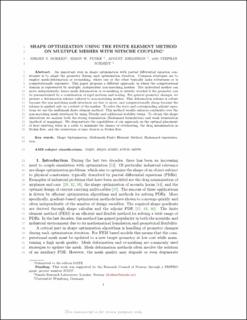| dc.contributor.author | Dokken, Jørgen | |
| dc.contributor.author | Funke, Simon Wolfgang | |
| dc.contributor.author | Johansson, August | |
| dc.contributor.author | Schmidt, Stephan | |
| dc.date.accessioned | 2020-07-01T09:41:00Z | |
| dc.date.available | 2020-07-01T09:41:00Z | |
| dc.date.created | 2019-06-25T14:01:54Z | |
| dc.date.issued | 2019 | |
| dc.identifier.citation | SIAM Journal on Scientific Computing. 2019, 41 (3), 1923-1948. | en_US |
| dc.identifier.issn | 1064-8275 | |
| dc.identifier.uri | https://hdl.handle.net/11250/2660264 | |
| dc.description.abstract | An important step in shape optimization with partial differential equation constraints is to adapt the geometry during each optimization iteration. Common strategies are to employ mesh deformation or remeshing, where one or the other typically lacks robustness or is computationally expensive. This paper proposes a different approach, in which the computational domain is represented by multiple, independent nonmatching meshes. The individual meshes can move independently, hence mesh deformation or remeshing is entirely avoided if the geometry can be parameterized by a combination of rigid motions and scaling. For general geometry changes, we present a deformation scheme tailored to nonmatching meshes. This deformation scheme is robust because the nonmatching mesh interfaces are free to move and computationally cheap because the scheme is applied only on a subset of the meshes. To solve the state and corresponding adjoint equations we use the multimesh finite element method. This method weakly enforces continuity over the nonmatching mesh interfaces by using Nitsche and additional stability terms. To obtain the shape derivatives we analyze both the strong formulation (Hadamard formulation) and weak formulation (method of mappings). We demonstrate the capabilities of our approach on the optimal placement of heat emitting wires in a cable to minimize the chance of overheating, the drag minimization in Stokes flow, and the orientation of nine objects in Stokes flow. | en_US |
| dc.language.iso | eng | en_US |
| dc.publisher | Society for Industrial and Applied Mathematics | en_US |
| dc.subject | Shape optimization | en_US |
| dc.subject | Finite element method | en_US |
| dc.subject | Nitsche coupling | en_US |
| dc.title | Shape Optimization Using the Finite Element Method on Multiple Meshes with Nitsche Coupling | en_US |
| dc.type | Journal article | en_US |
| dc.type | Peer reviewed | en_US |
| dc.description.version | publishedVersion | en_US |
| dc.rights.holder | © 2019, Society for Industrial and Applied Mathematics | en_US |
| dc.source.pagenumber | 1923-1948 | en_US |
| dc.source.volume | 41 | en_US |
| dc.source.journal | SIAM Journal on Scientific Computing | en_US |
| dc.source.issue | 3 | en_US |
| dc.identifier.doi | 10.1137/18M1189208 | |
| dc.identifier.cristin | 1707639 | |
| cristin.unitcode | 7401,90,26,0 | |
| cristin.unitname | Mathematics and Cybernetics | |
| cristin.ispublished | true | |
| cristin.qualitycode | 2 | |
